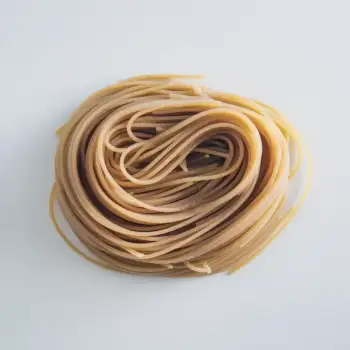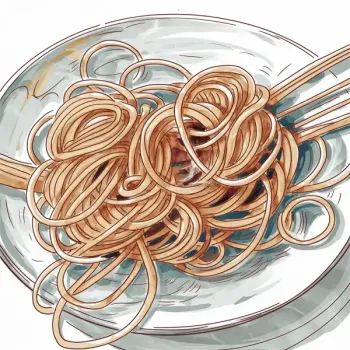Linguine and Spaghetti are both popular Italian pastas with subtle differences, ideal for various dishes based on their shape's affinity for holding sauces. Linguine's flatter form is perfect for thicker, creamier sauces, while Spaghetti's round strands suit lighter, oil-based sauces. Both are versatile and nutritious staples in Italian cooking.

Linguine is a type of pasta similar to fettuccine but narrower, often described as flat spaghetti. It originates from the Liguria region of Italy and is ideal for a variety of sauces, especially seafood-based ones.

Spaghetti is one of the most popular pasta types around the world. It is a long, thin, cylindrical pasta that is versatile and pairs well with a wide range of sauces, from simple tomato to hearty meat sauces.
Linguine and Spaghetti differ primarily in shape. Linguine is flatter and wider than spaghetti, which is round. This difference in texture means that Linguine is better at trapping and holding onto sauces, while Spaghetti is more suited for lighter, oil-based sauces. Additionally, the origin of Linguine from the coastal region of Liguria often sees it paired with seafood, whereas Spaghetti has a more universal application in Italian cuisine.

Your ultimate Recipe Box, Meal Planner, and Cooking Class all in one
Linguine is traditionally used in seafood dishes such as Linguine alle Vongole (with clams) or seafood marinara. Its broader, flatter surface captures the delicate seafood sauces, allowing for a harmonious blend of pasta and seafood in every bite. Spaghetti can be used in seafood dishes that require a lighter touch, such as Spaghetti with Garlic and Oil (Aglio e Olio) with shrimp. Its thin strands are perfect for simple tosses that coat the pasta evenly without overwhelming it.
In traditional Italian dishes, Linguine is best used in Pesto alla Genovese, where its flat surface perfectly complements the fresh, herby sauce. It's also great in a simple tomato sauce with basil and pine nuts. Spaghetti is the classic choice for dishes like Spaghetti alla Carbonara or Bolognese. The cylindrical shape holds onto the creamy, eggy sauce or the rich meat sauce, making it a satisfying meal.
For creamy sauces, Linguine is an excellent choice for dishes like Linguine with Alfredo sauce. The flat surface of the Linguine stands up to the thickness of the cream, creating a perfect sauce-to-pasta ratio. While not traditional, Spaghetti can be used with creamy sauces when a lighter texture is desired. It's all about personal preference, but a dish like Spaghetti with a mushroom cream sauce can showcase how versatile Spaghetti can be.
Both Linguine and Spaghetti provide similar nutritional values, with differences being minimal and often brand-specific.
| Nutrient | Linguine ( per 100 grams ) | Spaghetti ( per 100 grams ) |
|---|---|---|
| Fat | 1.5g | 1.3g |
| Fiber | 3.0g | 2.9g |
| Sodium | 6mg | 5mg |
| Protein | 12.5g | 12.5g |
| Calories | 359 | 358 |
| Carbohydrates | 71.5g | 71.3g |
While Linguine is traditionally preferred for seafood dishes, Spaghetti can be used as a substitute. The final dish will have a different texture and may not hold the sauce as well.
Yes, due to its slightly thicker and flatter shape, Linguine may require a bit more cooking time than Spaghetti. Always refer to the package instructions for the best results.
No, both Linguine and Spaghetti are typically made from the same ingredients: semolina or durum wheat flour and water. The main difference lies in their shape.
Linguine is generally preferred for creamy sauces as its flat surface holds onto thicker sauces better. However, Spaghetti can also be used if a lighter texture is desired.
The nutritional values of Linguine and Spaghetti are very similar, with only marginal differences that can vary depending on the brand or the way they are prepared.